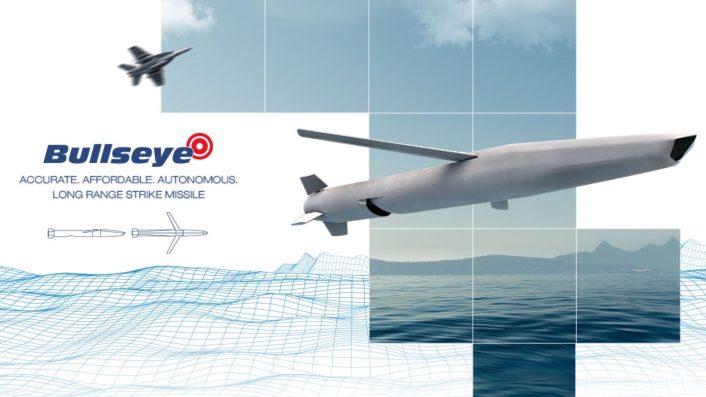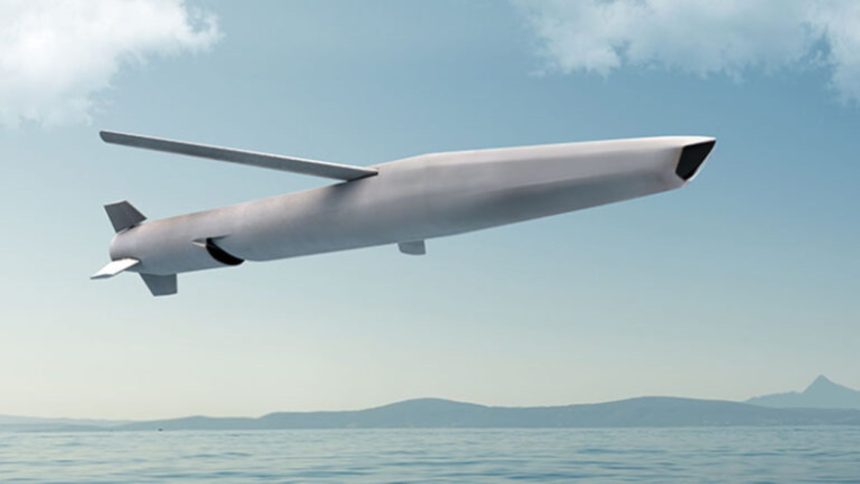Based on the Israeli Ice Breaker system, Bullseye provides multi-platform launch capabilities from air, ground and sea for strike mass at an affordable price.
General Atomics Electromagnetic Systems (GE-EMS) unveiled on Apr. 7, 2025, a full-sized mockup of the Bullseye long-range precision-strike cruise missile at the Sea-Air-Space 2025 Conference in Maryland. The weapon, based on the Israeli Ice Breaker system, will also be manufactured in the U.S. for U.S. military customers, GA-EMS mentioned.
The company describes Bullseye as a modular and scalable weapon which would be effective in “identifying and engaging a range of targets for long-range precision strikes.” The weapon is designed to meet U.S. military requirements and provide “multi-platform launch capabilities from air, ground and sea for strike mass at an affordable price.”
A highly advantageous feature is the missile’s design being already at TRL 8 (Technological Readiness Level 8), with Rafael already having “successfully performed aerodynamics, engine, seeker, launch integration and testing.” TRL is the scale used to indicate the maturity of a project, with level 8 meaning “Actual system completed and qualified through test and demonstration,” according to the U.S. Department of Defense definition.
Caught up with GA-EMS President Scott Forney on the show floor of #SAS2025 to learn about the new Bullseye Long Range Strike Missile, which the company is partnering on with Rafael Advanced Defense Systems. Check out my story and video interview here: https://t.co/86TmiEM3cw https://t.co/UMJT7WAcIo pic.twitter.com/wvv69PpwPD
— Aaron-Matthew Lariosa (@Aaron_MatthewIL) April 9, 2025
Being at TRL 8, the timeline for an eventual introduction in service would be reduced, with only flight qualification and testing to prove the missile’s operational readiness remaining before the start of deliveries by late 2025. The missile would be manufactured at GA-EMS’s facility at Tupelo in Mississippi, which specializes in “engineering, design, integration, test and manufacturing of highly complex, specialized systems, subsystems and components.”
“We are excited to work with Rafael to introduce Bullseye, a highly effective, deep-strike missile.” -Scott Forney, President GA-EMS
Learn more: https://t.co/WqopA8DL9M#FreedomToExplore #GeneralAtomics
— General Atomics (@GeneralAtomics) April 7, 2025
Collaborative effort
Both companies touched upon the other’s respective strengths in various aspects of weapons development that would drive the collaboration. Scott Farney, GA-EMS president said that the “highly effective deep-strike missile […] will support a wide variety of U.S. DoD and coalition partners’ precision-fires missions.”
“By leveraging Rafael’s extensive investment in the design, maturation and testing of a unique, modular missile, we can reduce risk and development costs and provide production-scale delivery of a highly capable, high-performance precision-guided missile at significant per-unit cost-savings,” Forney added.
Yuval Miller, executive vice president and head of Rafael’s Air & C4ISR Systems Division, said the partnership over Bullseye combines Rafael’s “combat-proven innovative 5th Generation missile technologies with GA-EMS’s advanced manufacturing, assembly, integration and test expertise.”
🇺🇸🇮🇱 Bullseye leverages the design of Rafael’s Ice Breaker missile, which Rafael already has ~1200 orders for from undisclosed customers.
See thread below for more details. 🧵⬇️
📹 @GeneralAtomics https://t.co/tsrwo9hN8O pic.twitter.com/uBrgTHXcc4
— Colby Badhwar 🇨🇦🇬🇧 (@ColbyBadhwar) April 7, 2025
Bullseye missile
The missile features a trapezoidal nose cone with an optical seeker that might use image and scene matching through a data library, kicking in during the terminal stage attack run for final target identification. The two arrays on top of the nose cone could be related to a satellite link, trading target updates from the launching platform and possibly allowing the weapon to be retasked in flight. They could also be related to technologies providing resistance to jamming.
Long-range air-launched cruise missiles like the JSM, British-French Storm Shadow/SCALP-EG, or the German KEPD Taurus 350 have optical seekers relying on either IIR (Imaging Infrared) or image correlation technologies like the DSMAC (Digital Scene Matching Area Correlator). They are activated during the terminal stage and are immune to RF (Radio Frequency) jamming.
Bullseye has fold-out wings, a cruciform-shaped tail fins, and a single ventral turbojet air intake. The shaping suggests an emphasis on LO (Low Observability). The weapon is largely expected to perform the same role of the Norwegian JSM (Joint Strike Missile) that is being integrated with the F-35A, with the Bullseye undertaking primarily maritime strike roles according to The War Zone, with possibly a secondary surface strike capability.
While GA-EMS’ latest release did not mention the Israeli Ice Breaker system, Forney confirmed to TWZ, ahead of Sea-Air-Space, that the new missile is “leveraging the Ice Breaker program.” The publication added that for potential sales, Forney personally unveiled the Bullseye missile to U.S. Secretary of Defense Pete Hegseth last week and company officials “have been previewing it with some […] senior customers across the Pentagon.”

The missile shares similar dimensions with the Rafael Ice Breaker. Bullseye will have a length of just under four meters (13.1 feet), a wingspan of a little over two meters (6.6 feet), a weight under 1,000 pounds (453 kg) and a range of over 186 miles (300 km). The warhead will be available in a 500 lb (226 kg) or a 250 lb (113 kg) version, both offering a dual-use general-purpose high-explosive and a penetrating effect.
TWZ additionally quoted Forney touching upon the JSM, describing Bullseye as a possible competitor in terms of range but at a significantly low cost.
Rafael’s Ice Breaker
Rafael says the Ice Breaker’s seeker is an IIR that also utilizes scene-matching algorithms and ATR (Automatic Target Recognition), which can “autonomously identify and engage only hostile targets.” The Israeli company adds that the missile is air, sea and land fire capable, while being “fully autonomous with man-in-the-loop” capability, and is resistant to “electronic countermeasures” for operating in “GNSS-denied environments.” This makes it an ideal weapon under A2/AD (Anti-Access/Area-Denial) umbrellas.
New!!
RAFAEL Unveils Ice Breaker 5th Gen, Air-Launched Long-Range Attack Weapon System
Ice Breaker is one of RAFAEL’s cutting-edge precision-strike solutions–it’s an air breathing missile with multi-service capabilities against a variety of high value land & sea targets. pic.twitter.com/E2BCQkVbzO
— Vayu Aerospace Review (@ReviewVayu) July 13, 2022
For navigation, the missile uses an INS (Inertial Navigation System), “anti-jam GPS” and “TERCOM (Terrain Contour Matching).” It can counter modern integrated air defense systems, relying on late detection through its passive seeker and low-level “terrain-following” and “sea-skimming flight pattern.”
The description reflects the requirements for a high-end war with peer adversary China in the western Pacific, where a large and diverse stock of offensive land and maritime strike weapons would go a long way in affording many tactical advantages. As mentioned earlier, the missile is very similar to the Bullseye, and it can be said they are the same missile in a lot of respects. But one can also assume significant changes to have been made to the U.S. version, although what those are is not yet known.
Interestingly, India’s state-owned arms manufacturer, Bharat Dynamics Limited, was also reported in Feb. 2025 signing an MoU (Memorandum of Understanding) to co-produce the Ice Breaker.









